Best food for 8 month old baby (and 9 to 10 month olds)
Oct 06, 2021, Updated Feb 21, 2024
This post contains affiliate links. Please see our disclosure policy.
Learn about the best food for an 8 month old baby, including both puree and finger food ideas!
Note: this post contains affiliate links. As an Amazon Associate, I earn from qualifying purchases.
Table of Contents
What should eight-month-old babies eat?

Chances are if you’re a parent, you’ve spent a good bit of time with the Google search bar.
‘How much tummy time should I give my baby?’
‘Is she getting enough breast milk?’
And, of course, the desperate 2 a.m. search ‘when will my baby sleep through the night?’
Each transition brings new questions, new challenges, and new opportunities for your baby to grow and thrive. (And spoiler alert: Google has no idea when your baby will sleep through the night.)
By about 6 months of age, most babies are ready for another big transition: starting solid foods. But this milestone leaves most parents feeling hesitant and nervous.
‘Do I start with finger foods? Purees? When do I introduce allergenic foods?’
‘What are healthy foods for babies?’
‘How often should I introduce a new food to my baby?’
As is true with every choice in parenting, there isn’t just one right way. Recommendations have shifted away from reliance on rice-based infant cereals in favor of a diet that includes a variety of foods. But it can be tough to figure out exactly where to start and how to proceed as your child gets older and has greater nutritional needs. My goal as a Registered Dietitian is to simplify the process and give you some helpful tools and suggestions to guide you and your new eater along the journey.
Your 8-month-old to 10-month-old’s development
Babies at 6, 7, and 8 months old will have more success with large pieces off food, around the size of 1-2 adult fingers. Your baby can grasp a soft, large piece of food and bring it to their mouth themselves.
Here is a steamed white potato wedge, with olive oil and a bit of pesto.
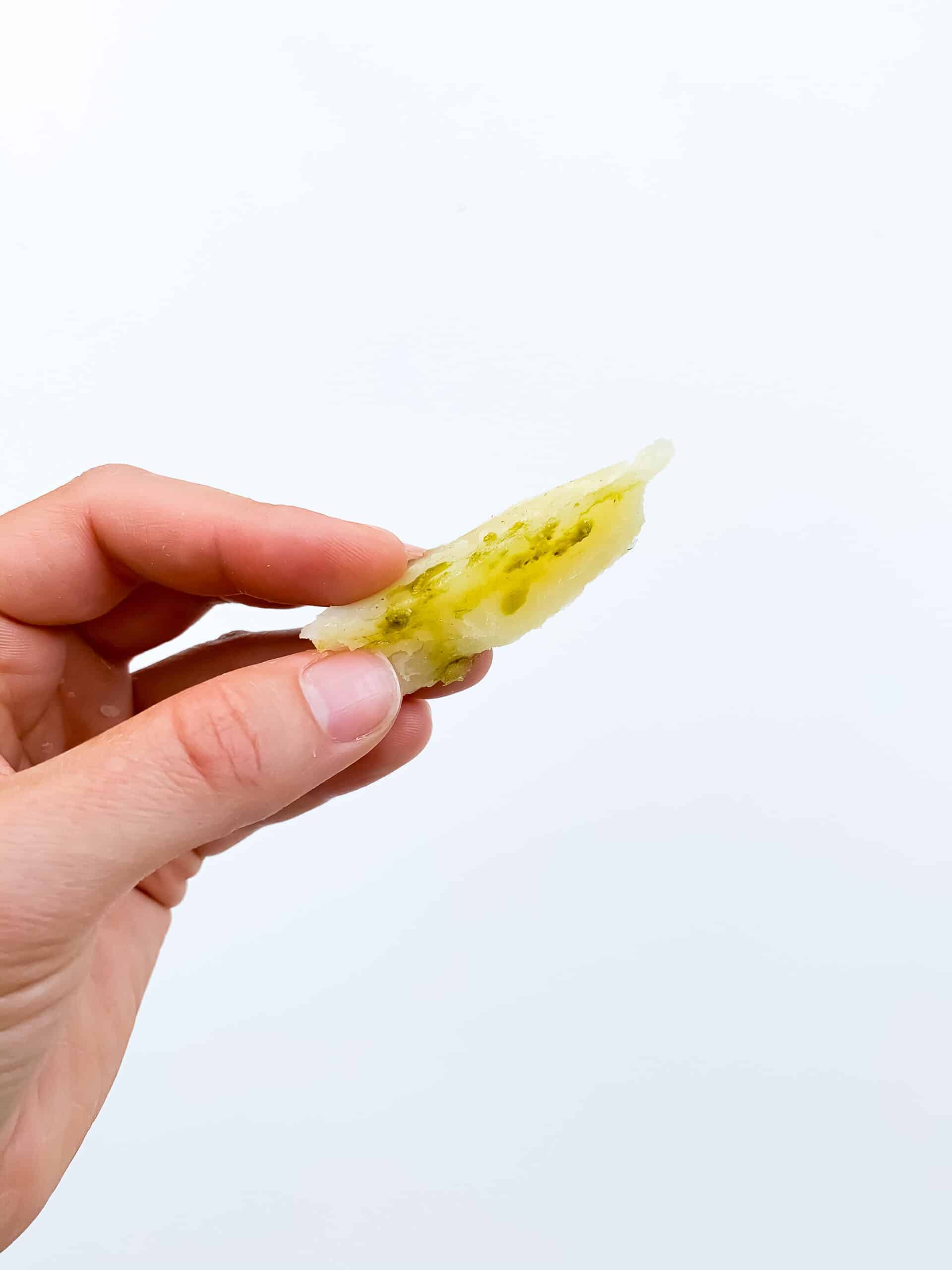
If you’re new to feeding baby, get Simply Solids: A quick guide to starting solids – it’s now FREE!
After a couple months of very messy practice, your 8-month-old baby will be gaining and refining their self-feeding, chewing, and swallowing skills.
Best foods for 8 month old baby
Until now, you’ve probably been offering mostly soft foods and purees. You might be comfortable serving foods like mashed sweet potatoes and avocado, or even slightly more textured foods like cottage cheese and oatmeal. You might be exclusively serving pureed foods. Or you might have taken a baby-led weaning approach..
Either way, you’re past the stage of first foods and are moving on to a wider variety of options. Your 8 to 10-month-old will generally be able to tolerate foods in slightly different shapes and textures than your 6-month-old could.
The 8 month mark may begin the transition to baby being able to more easily pick up smaller pieces. The pincer grasp generally develops around the 9-month mark and will get more refined as your baby practices with food, toys, and other objects. It may happen a little before 9 months, or a bit after. Every baby is different!
Once the pincer grasp develops, babies in this stage generally do well with foods cut into small-bite sized pieces and shredded foods. It’s still extremely important to be aware of common choking hazards like whole grapes, whole hot dogs, whole nuts, and anything else hard, very crunchy, or sticky.
Even without teeth, your baby has strong gums and can mash soft foods well. It really is okay for them to move past purees!
They cannot grind harder foods, like nuts, without their molars. But they have the ability to mash any food that you can easily mash with your thumb and index finger, or your tongue and the roof of your mouth.
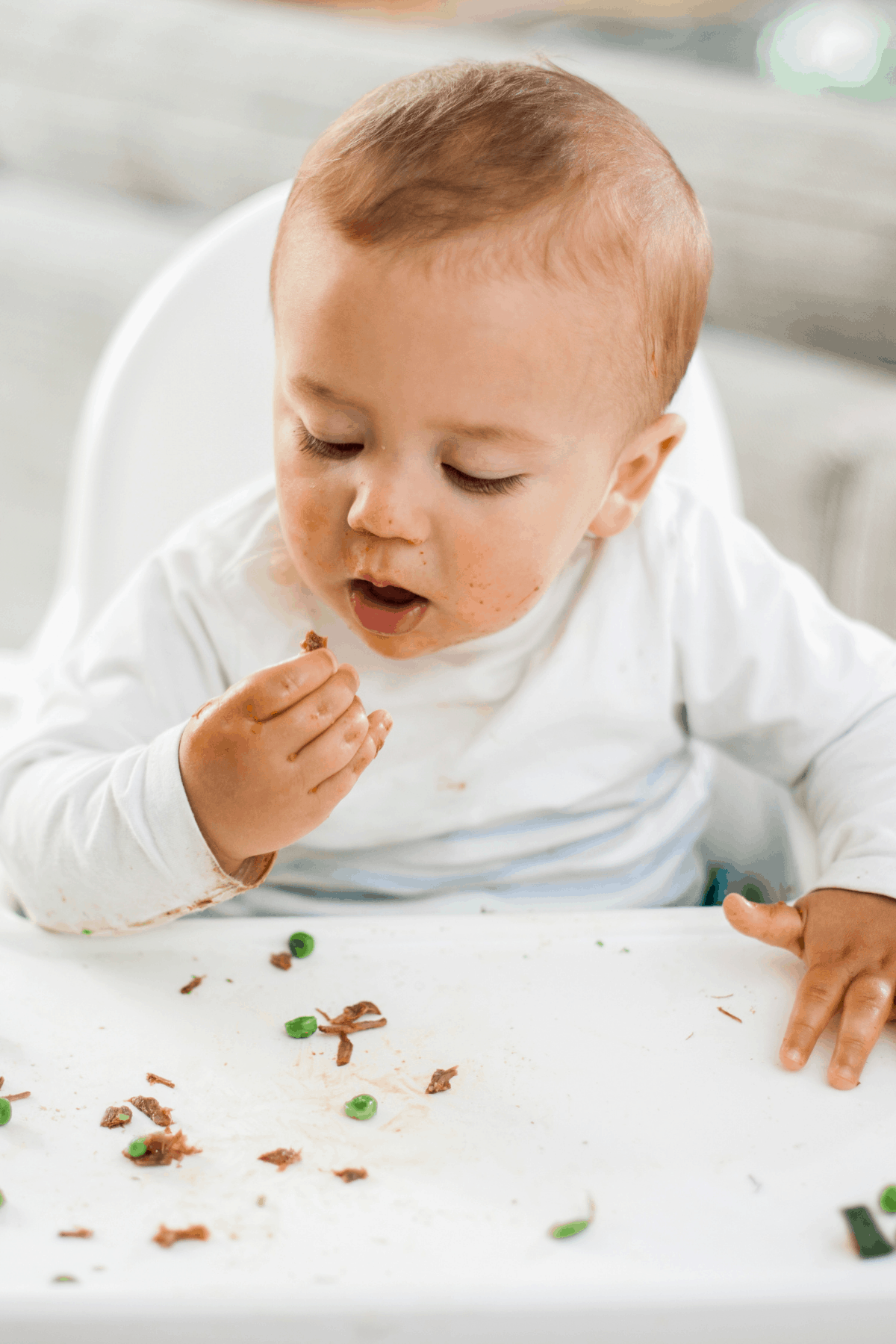
Frequency and Quantity
At 9 months, your baby should be eating 3 meals a day. Babies at this age are still getting a substantial amount of their nutrients through formula and/or breastmilk, but they may begin to drop feeds as they become more adept eaters. Additionally, baby’s intake at any given meal may vary, so don’t worry if your baby seems to eat more at one time and less at another. They are remarkably good at getting the nutrients they need when they are offered a variety of safe, healthy foods in addition to the recommended amount of formula/breastmilk.
Start with small portions and allow them to have more if they are still acting hungry. 1 tablespoon of each food is a good place to start.
Should I feed them before their bottle or after?
Make note of baby’s hunger cues and interest in food. Aim to feed them anywhere from 30-90 minutes after a formula/breastmilk feed so that they are not too frustrated and hungry to self-feed when offered solids.
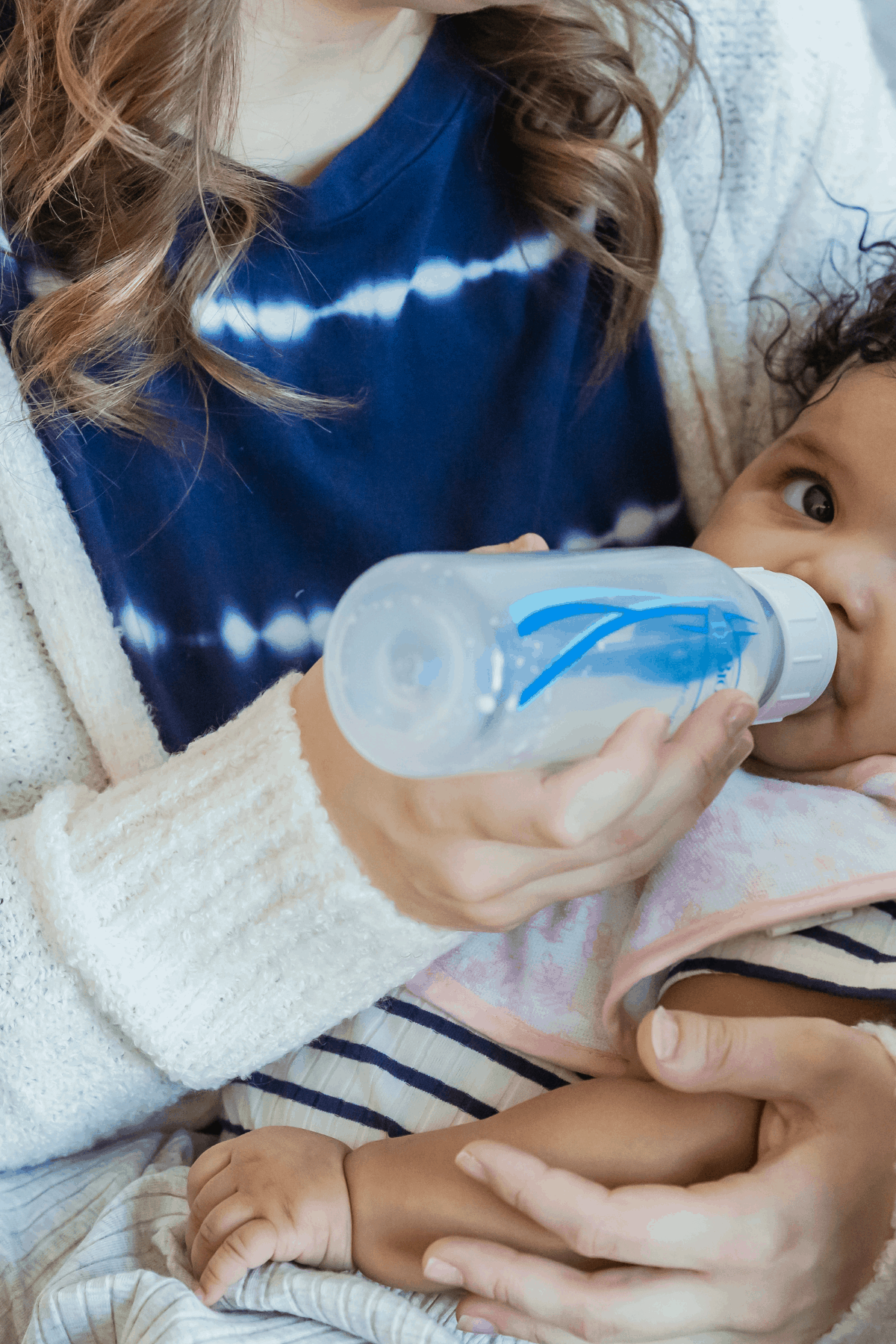
A Note on Allergens
If you haven’t already, I encourage you to introduce the common allergens (milk, soy, egg, wheat, peanut, tree nut, fish, and shellfish) into your baby’s diet. The repetitive introduction of allergens early and often can be preventative against the development of food allergies.
If your baby has a history of severe eczema or an already documented food allergy, be sure to discuss allergen introduction with your pediatrician or allergist, as they may have specific guidelines for you. And while allergic reactions are rare, it is good to be on the lookout for any sort of changes in your baby after the introduction of an allergen. Mild allergic reaction symptoms may include a few hives around the mouth or diarrhea, and more severe reactions may include widespread hives, vomiting, difficulty breathing, lip/face/tongue swelling, or change in skin color or demeanor. If you observe any of the mild reactions in your baby, stop serving the suspected allergen and contact your pediatrician. If you observe any of the severe signs in your baby, please call 911 or go to the Emergency Department immediately.
To learn more about how to introduce allergenic foods to your baby, read Introducing Allergenic Foods to Your Baby. Another helpful tool if you feel overwhelmed by trying to serve all of those common allergens is to use Spoonful One, daily mix-ins developed by a pediatric allergist.
Quick Tips for Feeding Your 8 month old, 9 month old, or 10 month old
Have your baby eat when you eat
Modeling eating for them is a very helpful practice in babies learning how to self-feed a variety of foods. If you are spoon-feeding your baby, now is a great time to offer them pre-loaded spoons to grab and self feed. Safely prepared finger foods will also give them practice self-feeding. Or, feed them intermittently as you take bites of your own food. Babies take cues from our behavior, so this modeling approach helps them solidify their eating skills.
Prioritize foods with fat and iron
Fats should be unrestricted in the first 2 years of life. Include nutritious fat sources in your baby’s diet such as olive oil, avocado, and nut butter. Iron is also important for your 8-10-month-old-baby, as their reliance on iron stores from their time in utero have run out. Some iron-rich options for your baby’s diet include meat, egg yolk, salmon, beans, and lentils.
Limit baby’s intake of sodium for the first year
Feel free to season your baby’s food with herbs and spices, but hold the salt until after their first birthday and opt for items that are low in sodium when possible. Some foods will have sodium, like store bought bread. You do not need to avoid this completely. Aim to keep sodium to less than 300 to 400 mg per day for baby. When cooking, remove baby’s portion before adding salt for the rest of the family.
Avoid honey and added sugar
Honey can be contaminated with spores of a harmful bacteria that can multiply and cause infant botulism, so avoid all honey in foods- even if it is cooked. It is also recommended to limit added sugar for the first two years of life so that your child maximizes their consumption of nutrient-dense foods. The introduction of sugary snacks and foods can displace nutrient-dense foods in the diet and create a preference for those foods with less nutritional value.
Use pouches, puffs, and teethers strategically
These foods are fine to introduce and offer, but be strategic about your use of them. Pouches are great for on-the-go, or for when you need another caregiver to feed your child. But relying too heavily on pouches can hinder their oral motor skill development and perpetuate picky eating. I like to use them for convenience and limit them to 1 per day. Items like puffs, melties, and teething biscuits typically don’t contribute much nutritionally, but can still be useful dietary aids. Teething biscuits might be used as a base for a spread, and puffs could be offered to keep your child occupied and working on that pincer grasp while you wait for your food at a restaurant. If you want nutrient-dense pouches and puffs, definitely check out Serenity Kids.

Quit the rice cereal, if you haven’t already
Rice may contain levels of arsenic that are potentially unsafe for baby. Rice cereal is not a necessary food for baby so it’s best to ditch it, and products made from rice flour, for baby. Rice is okay, but limit to no more than 2 to 3 times per week, prioritizing rice grown in California for lower levels of arsenic.
It’s okay, but not necessary, to offer water
Baby gets enough fluid without extra water. They meet their hydration needs from formula or breastmilk, so there is no need for a baby of this age to drink a prescribed amount of water. However, offering water from an open cup or a straw cup can help refine oral motor skills that are useful for language development. And, sometimes it’s just nice to have a sip of water while eating! Offer 2 to 3 ounces in a cup. The ezpz tiny cup is amazing for practice learning to drink from an open cup. This cup is a good first straw cup to practice with. Here is a quick video tutorial to teach baby how to drink from a cup!

Best food for 8 month old baby
Pre-loaded Spoons:
Use these ideas to load a spoon and put it in baby’s hand. Practice hand-over-hand first if they are having trouble bringing the spoon to their mouth. I love these spoons and these spoons for babies. Use 2 or even 3 spoons per feeding. Sometimes baby holds onto one in one hand while using the other to eat. And you can load up an extra spoon while baby is working on the other.

- Sweet potato- all kinds
- White, orange, purple! Mash and mix with breastmilk or nut milk to thin.
- Yogurt + mashed fruit
- Plain whole milk or full-fat coconut yogurt with no added sugar and mashed fruit; blackberries, kiwi, and banana work well.
- Avocado mash
- Mix with quinoa or whole wheat couscous, or combine with full-fat ricotta cheese for a more nutrient-dense option.
- Hummus or white bean dip
- If homemade, use olive oil, fresh spinach, garlic, and lemon and blend until smooth for a tasty spread with an added veggie boost,
- Nut butters
- Peanut, almond, cashew; thin with breastmilk, mix into yogurt, or stir into baby oatmeal.
- Cottage cheese
- Offer full-fat cottage cheese alongside avocado or tomato cut in wedges.
If you want healthy, nutritious, pre-made blends on hand, I absolutely love Little Spoon!
Pro-tip: when you visit Little Spoon, you can sort their blends flavors by Benefits. Select “brain” – those are my top choices for baby!

Finger foods:
- Acorn Squash
- Roast acorn squash in wedges with olive oil and seasonings
- Steamed broccoli
- Steam whole broccoli florets until soft, drizzle with olive oil and lemon juice
- Eggs
- The yolk is the most nutritious part, but serving the whole egg is great too! Serve as scrambled eggs or as an omelette cut into strips or bite sized pieces
- Beans and lentils
- Cook lentils until soft and offer beans flattened by hand or refried
- Banana
- Offer half a banana with nut butter spread thinly across it, sprinkle with ground flaxseed, chia seed, or hemp seeds for a nutritional boost
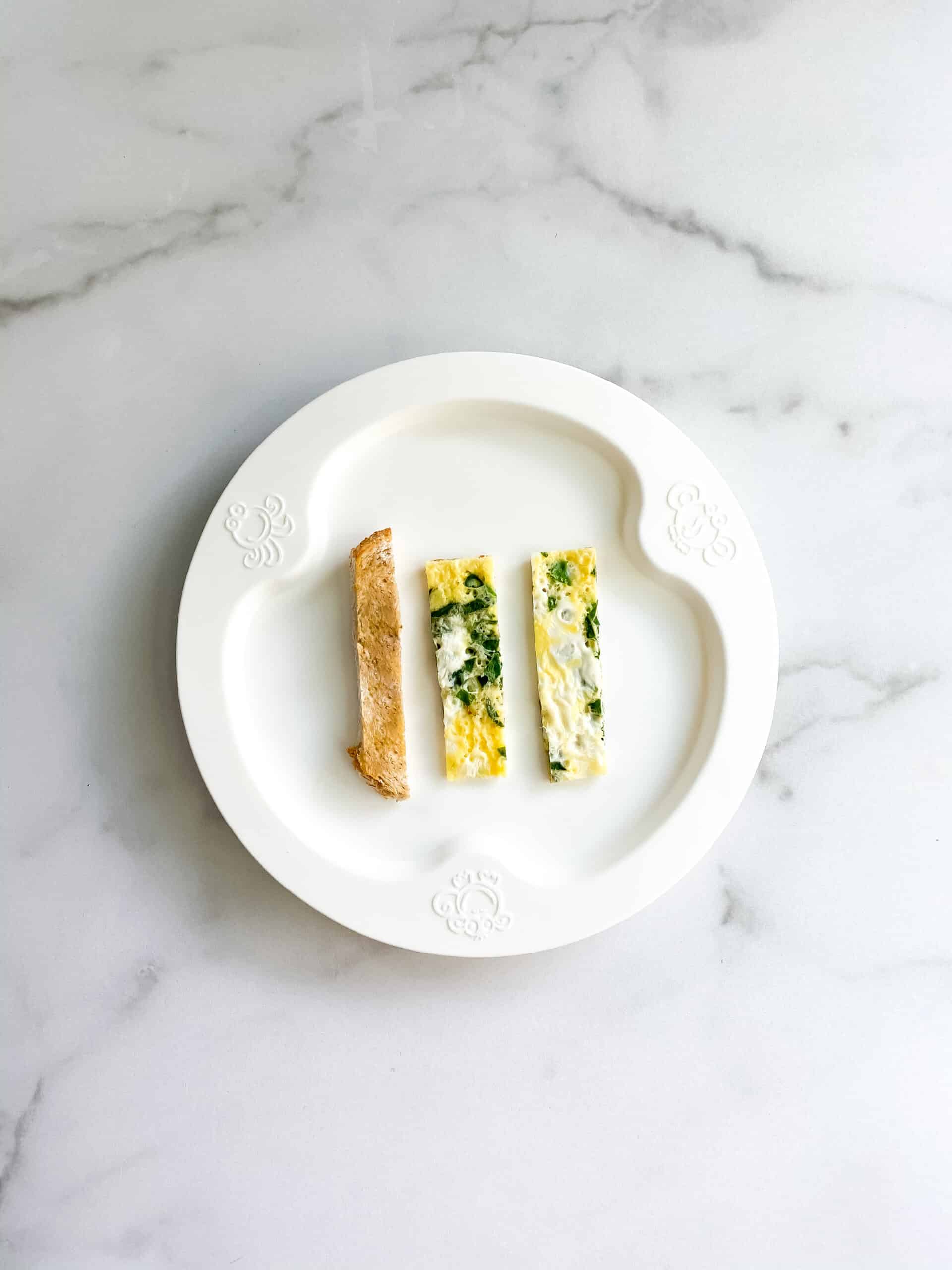
Finger food prep
Finger food preparation is important both for your baby’s safety and for their ability to successfully pick up and eat what’s offered. A good rule of thumb is to serve finger foods in wedges or spears about the width of one or two of your fingers.
If you are serving foods that can’t be made into those shapes, or baby has a good pincer grasp, make sure they are soft foods in bite size pieces. And if you want to serve hard fruits and vegetables like apples or broccoli, steam, saute, or roast them until they are soft enough to break apart between your fingers.
Laying a foundation
Your 8-10-month old is seemingly growing by the day and on the brink of even more major developmental milestones. They are becoming more and more independent, and eating is a new avenue through which they can explore and develop confidence in new skills. The skills they are learning now will serve them for the rest of their lives- not only how to pick up food, chew, and swallow, but also how to make decisions about what they eat, how to listen to their hunger and fullness cues, and how to ultimately be in tune with their own bodies.
So as you’re scrubbing the sweet potato off your curtains and wiping down the high chair for what feels like the millionth time this week, remember that you are laying the foundation for your baby’s healthy future by helping them develop some extremely important skills and tools that they’ll use long after they graduate from their high chairs.
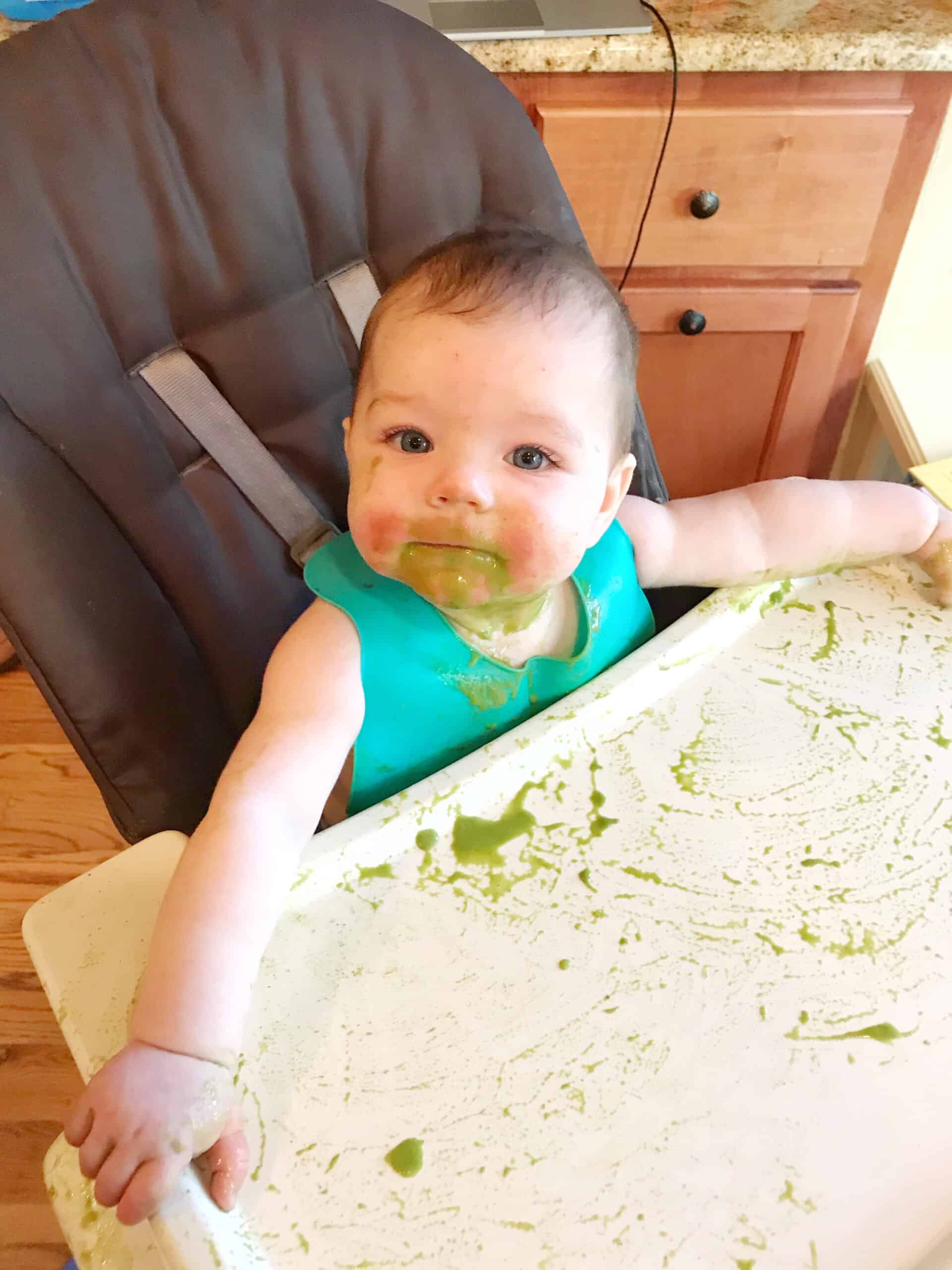
References
- Daniels L , Heath AL, Williams SM , et al. Baby-Led Introduction to SolidS (BLISS) study: a randomised controlled trial of a baby-led approach to complementary feeding. BMC Pediatr 2015;15:1–15.doi:10.1186/s12887-015-0491-8
- Caffarelli, C., Di Mauro, D., Mastrorilli, C., Bottau, P., Cipriani, F., & Ricci, G. (2018). Solid Food Introduction and the Development of Food Allergies. Nutrients, 10(11), 1790. DOI: 10.3390/nu10111790. Retrieved June 4, 2021.
- Strohm, D., Bechthold, A., Ellinger, S., Leschik-Bonnet, E., Stehle, P., Heseker, H., & German Nutrition Society (DGE) (2018). Revised Reference Values for the Intake of Sodium and Chloride. Annals of nutrition & metabolism, 72(1), 12–17.











